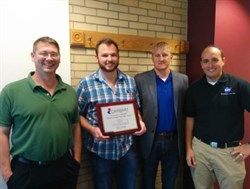 A group of undergraduate students from the Department of Aerospace Engineering at Texas A&M University won the Consortium for the Advancement of Shape Memory Alloy Research and Technology (CASMART) Student Design Challenge. Cullen Eckhert, Kelli Pickett, Hannah Stroud, Kanika Gakhar and Tyler Fink were under the direction of graduate mentors Robert Wheeler and Robert Saunders, as well as faculty advisors Dr. Dimitris Lagoudas and Dr. James Boyd.
A group of undergraduate students from the Department of Aerospace Engineering at Texas A&M University won the Consortium for the Advancement of Shape Memory Alloy Research and Technology (CASMART) Student Design Challenge. Cullen Eckhert, Kelli Pickett, Hannah Stroud, Kanika Gakhar and Tyler Fink were under the direction of graduate mentors Robert Wheeler and Robert Saunders, as well as faculty advisors Dr. Dimitris Lagoudas and Dr. James Boyd.
The challenge was intended for undergraduate and graduate students working with CASMART faculty advisors to consider innovative approaches to developing design tools and hardware using shape memory alloy (SMA) technology. Students had the opportunity to showcase their creativity by applying engineering theories and methods they’ve learned, using engineering design principles, and leveraging CASMART members’ experience to address SMA design challenges in the automotive, aeronautics and space industry.
The goals for this group were to design a lightweight and efficient deployment device for a solar array and to fabricate a proof of concept or prototype. Each of the undergraduates worked on solving a specific engineering problem, ranging from a thermal analysis of a satellite in a given orbit to vibrational analysis during launch conditions to the design and operation of a solid state actuator. Each reported on their progress every week during a group meeting.
Every two weeks, the students worked on a different facet of the overall design and developed the necessary tools.
“Overall, the students performed very well and quickly developed their problem solving capabilities by tackling real problems on a weekly basis,” said Wheeler. “As the semester progressed, they also learned how the different requirements or operating conditions can lead to unexpected design implications, as the design of each part affected the system as a whole.”
The design was completed during the spring 2015 semester. During the summer 2015 semester, one of the students, Eckhert — funded through the NSF REU program — worked with Wheeler to build the proof of concept or prototype.
Wheeler presented the completed project at the Smart Materials, Adaptive Structures and Intelligent Systems (SMASIS) conference in September. The group also published a conference paper, “Design of a Reconfigurable SMA-Based Solar Array Deployment Mechanism.” The judges for the competition included senior researchers from Boeing, NASA Glenn, NASA Langley, Sandia National Labs and General Motors.
Wheeler will be taking the work and developing a set of design tools with the CASMART group to allow for future designs of SMA-based actuation systems.
CASMART was established to promote the growth and adoption of SMA actuation technologies by achieving new understanding of the materials, fostering dissemination of technical knowledge and facilitating application of that knowledge. The consortium was initiated in 2007 by Boeing, NASA Glenn, NASA Langley and Texas A&M. More than 16 other organizations have joined to advance the state of the art for SMA technology through a synergy of academic, industry and government expertise.